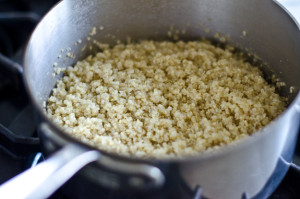The key to staying organized is planning ahead—and in particular, to spend a bit of time each week preparing your weekly menus in advance. Batch cooking (cooking more than you need in one sitting) is an important technique that will ensure you can cook and eat a variety of nourishing foods throughout the week.
I like to focus on the importance of planning, as it not only saves time and money, it offers a great deal of flexibility and variation in your daily or weekly meals. Batch cooking encourages us to acknowledge and integrate which foods we really enjoy and desire, and what we know we should eat. The fact is, you’re unlikely to prepare foods that you wouldn’t eat as part of your weekly repertoire. So, plan to cook the foods you crave for flavor and nutrition.
Let’s touch on some basic strategies for batch cooking grains, legumes and vegetables.
Batch cooking can mean different things to different people, but the concept is the same. For some, it might mean cooking two quarts of beans; for others it may be a much larger quantity. Regardless, the point is to make the most of your time in the kitchen. It takes the same time and effort to prepare two cups of quinoa as it does to cook six. So if you eat quinoa on a regular basis, you might want to prepare a large batch that you can have it ready all week.
First, be sure you have all the necessary items for the recipes you will be preparing; it’s a good idea to make sure you plenty of these ingredients on hand. The bulk bins at your supermarket or natural grocery store is a good place to start. Given that grains and legumes are dried items with long shelf life, it makes sense to always have them on hand.
Here are some suggestions for common staples that you may want to have prepared for the week. Keep in mind that how much you prepare will depend on your personal preferences and how many people will be eating your meals. Cooking for yourself and cooking for a large event or family require vastly different quantities.
Keep prepared on hand (recommendations):
A batch of beans
A batch of grains
A starchy vegetable, such as sweet potatoes
Grilled, roasted, steamed or marinated vegetables
Raw vegetables Seasonings/Sauces
By batch cooking these staples in advance, you just need to add a few fresh vegetables and seasonings to create a variety of yummy, nutrient-dense meals in a just a short amount of time.
For this to work, it needs to be a priority, so it is important to plan cooking time. For example, if you do your grocery shopping on Saturday, you may want to do your batch cooking on Sunday. Or, you may want to schedule your cooking day for the same day as your local farmer’s market. You know your schedule best, so choose a day you’re able to set aside some time; typically a 90 minute block of time, once a week is sufficient. Within that time period, you can simultaneously simmer a pot of beans or a soup, clean, slice and store some produce, make your favorite sauce, dip or dressing, and prepare some grains. Oink!
Here are some efficiency tips to ensure your 90 minutes goes well:
~Clean/sanitize your work surfaces.
~Ensure you have all the correct equipment: pots, cutting boards, knives, ample storage containers, etc.
~Gather all the ingredients you need.
~Have a plan for the order you will prepare your food, (otherwise, they’ll just sit in the refrigerator until you throw them out). For example, the beans and grains have longer long cooking times, but the active time to prepare these simple items takes a few short minutes. Prepared them first, and then leave them to simmer while you prepare your produce for the week. Even if you don’t plan on cooking them yet, you can prepare vegetables/fruits that need to be washed, chopped, seeded and peeled. Store these ingredients in airtight, sealed containers, refrigerating as necessary.
~Have some idea of how you will stretch your ingredients throughout the week. How will you use your beans and grains throughout the week in different ways? ~If you aren’t able to finish eating your prepared ingredients during the week, store the excess beans and grains in airtight/sealed containers and freeze them. They’ll last up to six months in the freezer, and can be quickly thawed for future lightning-fast meals.
How would you take an ingredient and stretch it through the week into multiple meals? Grains and legumes are great candidates for stretching meals. Here are a few example: ~Cooked grains: Add to a tortilla or wrap, then top with salsa and vegetables for a quick lunch. Grains can also be added to salads and are also the base of meals in bowls!
~Cooked beans: Toss into a soup or stew to add bulk/texture/nutrients.
~Grilled/roasted vegetables: Add to a warm stir-fry or grain bowl, top with your freshly made sauce.
Most beans and peas take a while to cook, so they’re an excellent candidate for batch cooking. There are so many delicious ways to incorporate legumes into your weekly repertoire, so make more than you anticipate consuming and freeze the excess in an airtight, sealed container for simplicity down the road!
I love using a variety of beans in tacos/wraps because they are infinitely flexible; you can add nearly anything to a shell, (flour or corn tortilla, a coconut wrap or even a lettuce wrap!) like salsa, spinach, mushrooms, avocado, seeds/nuts, grains, different herbs and lots more, to make an easy to eat hand-held meal. There are also some great recipes for bean burgers out there! But I’m saving that for another post! Squeal!
I hope this helps you find simplicity and variety in the kitchen. We have to retrain our imagination wheels and, depending on how long you’ve strayed away from cooking, that could take a little time, so be patient, creative and bold. Try new recipes, explore flavors, and save time and money all while getting healthy! Oink!


I will be sharing some of the mentioned recipes in another post very soon! Squeal!
Hi Shauntell,From the absolute beinginng of my bodybuilding career in 1954 I bought into the “meat myth” of the bodybuilding world. Requiring me to gorge myself with so much animal flesh there was no room left for any vegetables, fruits or grains, so I took a vitamin mineral multi pack each morning, along with various protein powders, liquid amino’s, etc. I also no longer eat any refined or processed products which, of course, all supplements are, so I have stopped all supplementation. It took many years for me to stop believing I needed “extra” protein but I have never been in such good health according to my blood and heart work. I make my own fruit drink by using entire pieces of fruits including core and seeds in the blender and mixing with water to my favorite consistency and freezing and refrigerating a couple of gallons at a time. That way I do not have to be continually making up drinks. In the fridge at the moment is a pineapple, banana, watermelon, cantaloupe drink. Sometimes I make a really thick batch, freeze it in small separate containers and scrape it out like a sherbet or iceee for a TV snack with some nuts. It will not be anything near as sweet as commercial products all of which are loaded with added sugar. I use Aloe Vera leaves on my skin and then eat the remainder of the leaf once I have wiped all of the sap on my skin. It is loaded with nutrients, but incredibly bitter at first (you get used to it rather quickly). So I was shocked one day when my gardener gave me a bottle of Aloe Vera juice from the market and it was as sweet as any carbonated drink. In order to get it that sweet it would have to have 1000 parts added sugar to every 1 part Aloe.
Your tone and enthusiasm really shows in your writing. Great post!